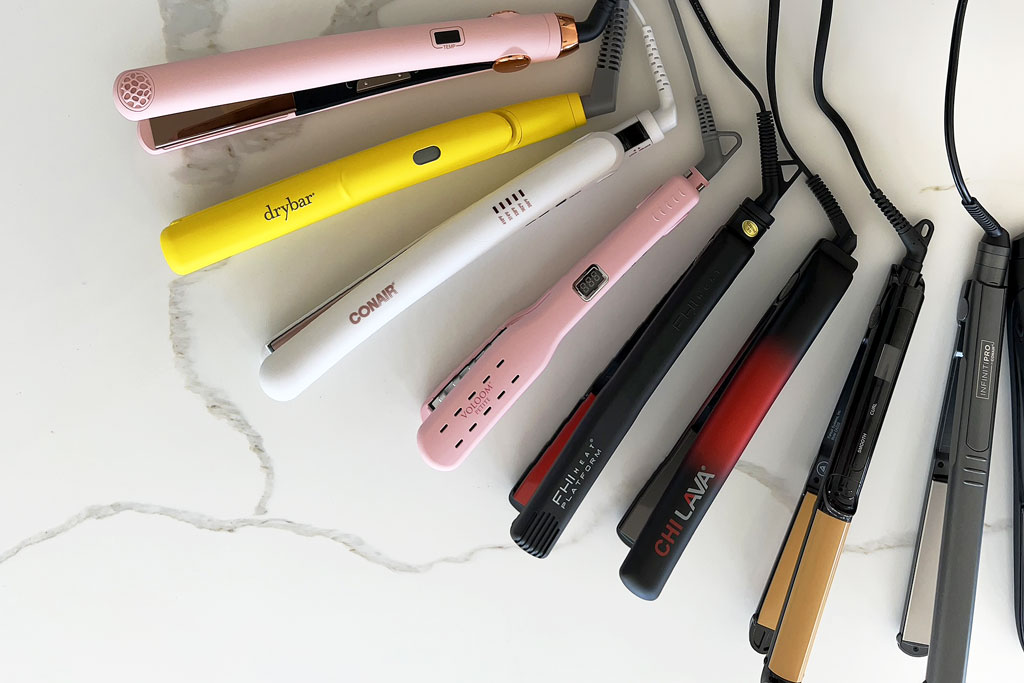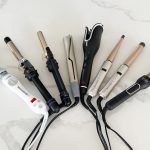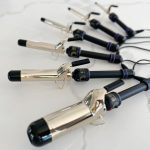 Are you looking for the best flat iron to give yourself that perfect hairstyle?
Are you looking for the best flat iron to give yourself that perfect hairstyle?
But which one is better and which should you choose?
This blog post will provide a detailed comparison between titanium and ceramic flat irons so that you can decide what’s right for your hair type and goals.
So, if you’re torn between these two choices, keep reading as we walk through their individual benefits and drawbacks!
Don’t forget to visit our comprehensive guide to choosing a flat iron to make an informed decision.
How do They Differ From Each Other?
Ceramic and titanium tools are both safe to use on your hair – but don’t be fooled, these two materials are very different in their performance!
The real difference between these two materials comes down to the way they distribute heat to your hair.
Ceramic Flat Irons
Ceramic flat irons heat up slowly, but evenly and in a much more gentle way than titanium.
You’ll notice it might require more passes to completely straighten your hair, but no worries! Compared to titanium plates, ceramics are much less likely to burn your hair and less damaging in the long run!
So, if you have fine or fragile hair, a ceramic flat iron is an ideal option for your styling needs.
Ceramic flat irons are also a great choice for daily use and anyone from experienced users to beginner home stylists.
Titanium Flat Irons
On the other hand, a titanium flat iron heats up faster and recovers the lost heat quicker than a ceramic flat iron.
That means, you won’t need to pass over each section multiple times and you can style your hair quickly – great for coarse, thick, and hard-to-straighten locks.
Titanium technology is also perfect for those tough jobs like keratin straightening treatments and silk press that require consistent heat over an extended period.
However, they do carry more risks for your hair. Titanium plates can overheat and burn your hair in seconds if you don’t work fast enough with them during styling.
That’s why titanium flat irons are best suited for experienced at-home stylists and professionals who mastered heat management.
Now, let’s look at the features closer to get a better understanding of how titanium and ceramic flat irons perform.
Properties Of Materials Comparison
Heating Method:
While both options heat up quickly and are hot enough for styling, their heating methods are quite different.
Ceramic flat irons use far infrared heating in the same way that the sun does. This method is gentler on your locks as it heats up the hair from the inside out by “radiating” heat.
On the other hand, titanium flat irons use conduction to transfer heat which ultimately heats up the surface of your hair shaft. This method can be more damaging due to the intense heat that is used.
So, if you’re in the market for a more gentle and safer option for your hair, then ceramic is the way to go.
Heat Distribution:
Ceramic heats up more evenly than titanium, this is due to the method used to distribute the heat through your hair.
Evenly heated plates mean you don’t have to worry about having any “hot spots” that overheat and harm your hair or “cold spots” that give you flyaways and unevenly straightened tresses.
It’s no surprise that some brands have even gone a step further by adding in sensors that keep the heat even and consistent across both plates throughout styling.
Heat-Up & Recovery:
Metals are better conductors of heat than ceramics. That’s why titanium flat irons heat up quicker and recover their temperature faster than their ceramic counterparts.
We would like to highlight here that “initial heat time” is important, but “heat recovery time” matters even more. This is because when the flat iron plates come in contact with the hair, they cool down due to the huge temperature transfer. And after each pass, titanium flat irons return to their target temperature much faster than ceramic flat irons.
As a result, titanium flat irons can maintain consistent performance throughout styling since they provide fast, single-pass straightening.
Frizz Control:
Titanium flat irons naturally produce more negative ions than ceramic flat irons, due to the nature of the metal.
Negative ions help seal the cuticles of your hair to reduce frizz and flyaways.
Ceramic flat irons aren’t as good when it comes to combating frizz, but it isn’t all bad news; they are better in terms of hair conditioning. With ceramic heat styling tools, you get treated with a shinier and smoother finish than with other types of flat irons.
Durability:
When it comes to durability, titanium is definitely the winner.
As a metal, titanium flat irons are resistant to cracks. It’s also scratch and corrosion-resistant.
With proper care, a titanium flat iron should last for several years.
On the other hand, ceramic flat irons could end up cracking or breaking if you drop them — even if you don’t notice it right away.
This isn’t just bad news for the look of your straightener – it can also impact its performance. That broken part could cause painful pull-outs during use and risk your safety.
How Does Tourmaline Infusion Change The Game?
Tourmaline-infused flat irons are the newest and most popular type of flat iron on the market and with good reason. They are changing the game when it comes to frizz control.
Wondering what tourmaline is and how it works?
It’s actually a semi-precious gemstone that can be crushed up in to a fine powder and used to coat ceramic or titanium flat iron plates.
What makes it useful for hair styling is its ability to emit a huge amount of negative ions when heated up.
A tourmaline-infused ceramic flat iron produces six times more negative ions than ceramic alone.
These negative ions help neutralize the positive charge that dry and damaged hair holds.
Tourmaline will actually close the cuticle of your hair shafts and maintain moisture, resulting in a beautiful and healthy look without any unruly flyaways!
So, if you live in a humid environment or your main priority is frizz control then tourmaline is certainly your best friend.
Don’t forget that tourmaline infusion will still provide you with the natural properties of the underlying material – ceramic or titanium with more frizz-fighting power.
So, make sure to choose the right type of plate material first and then look for tourmaline infusion options.
And while tourmaline-infused flat irons can be more expensive than other options, they are definitely worth the investment.
Sum Up
Ceramic Flat Iron
- Gentle heating – distributes heat evenly.
- Multiple styling passes may be required.
- Ideal for daily use and easy home styling.
- Less likely to burn hair.
- Great for fragile hair.
Titanium Flat Iron
- Faster heating – heats up quickly and recovers lost heat.
- Styles hair quickly.
- Ideal for stubborn and thick hair.
- Great for professional styling (including keratin treatments and silk press).
- Risk of overheating and burning hair.
Tourmaline-Infused Flat Iron
- Best option for frizz control.
- Neutralizes the positive charge of dry and damaged hair.
- Closes the cuticle of your hair shafts and maintains moisture.
- Great for humid environments.
- More expensive but worth the investment.
In conclusion, choosing the right flat iron for your hair depends on your styling needs, budget, and hair type. Both ceramic and titanium flat irons have pros and cons which you need to consider before making a purchase.
Happy styling!





Many thanks for clearing this! I`ve been searching online and found many sites detailing the difference and your post has been the most thorough and professional education on this topic I found. Thanks again!
I left out `Dear Isabel`, sorry for that! 🙂
Super Teodora! 🙂
Thanks a lot for the post! I now have a better idea about what my hair needs!
Would a ion titanium platinum flat iron work for my baby fine hair and short mini travel one